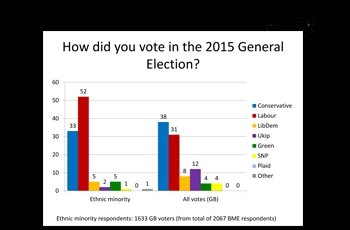- Home
- News & Blogs
- About Us
- What We Do
- Our Communities
- Info Centre
- Press
- Contact
- Archive 2019
- 2015 Elections: 11 new BME MP’s make history
- 70th Anniversary of the Partition of India
- Black Church Manifesto Questionnaire
- Brett Bailey: Exhibit B
- Briefing Paper: Ethnic Minorities in Politics and Public Life
- Civil Rights Leader Ratna Lachman dies
- ELLE Magazine: Young, Gifted, and Black
- External Jobs
- FeaturedVideo
- FeaturedVideo
- FeaturedVideo
- Gary Younge Book Sale
- George Osborne's budget increases racial disadvantage
- Goldsmiths Students' Union External Trustee
- International Commissioners condemn the appalling murder of Tyre Nichols
- Iqbal Wahhab OBE empowers Togo prisoners
- Job Vacancy: Head of Campaigns and Communications
- Media and Public Relations Officer for Jean Lambert MEP (full-time)
- Number 10 statement - race disparity unit
- Pathway to Success 2022
- Please donate £10 or more
- Rashan Charles had no Illegal Drugs
- Serena Williams: Black women should demand equal pay
- Thank you for your donation
- The Colour of Power 2021
- The Power of Poetry
- The UK election voter registration countdown begins now
- Volunteering roles at Community Alliance Lewisham (CAL)
Black British Voters Are On the Move
In analysing how the BME vote in May's general election might influence the result, OBV suggested that the BME vote held the key to number 10. Some though the idea preposterous, others thought we were being propagandist.
But it turns out we were right. The reality is the BME vote has now matured into the most significant urban vote in Britain. A research study commisioned by British Futures and conducted by Survation, shows that the BME vote had increased from 12% -to 20% depending on the particular constituency.
This research supports our view that whilst there remains a significant issue of voter registration among sections of BME voters, nevertheless we are turning out in increasing numbers. In 2010, 2.5 million BME voted in the general election, whilst in 2015 that number increased to 3 million.
This research suggests a 56% BME turnout. Whilst it's clear we are making good progress, the fact remains there are many more opportunities for the political parties to engage with and secure additional BME votes. Their challenge is to ensure broader appeal by a more distinct political offer to inspire people to vote.
Nevertheless these figures are a huge vindication for the work of the OBV team who have worked relentlessly hard to mobilise the BME vote. This year's 'Don't drain the colour from Britain' featuring Hollywood Homeland start David Harewood among others, was particularly effective and attracted huge media attention nationwide.
These figures chime well with a smaller survey conducted by the British Election Survey. This was based on 762 ethnic minority responses taken in March 2015 and showed Labour on 52% , Conservatives on 24%, with 5-6% for each of the Lib Dems, Greens and UKIP. All of these initial findings are reinforced by this latest research.
In terms of the detail of the research here we find astonishing shifts in BME voting patterns. In this election 33% BME voters voted Tory. In terms of numbers, based on an estimated 3 million BME voters taking part in the election, Labour won 1.6 million; Conservatives secured one million votes, whilst the smaller parties, Lib Dems and Greens achieved 160,000 and 150,000 votes respectively, with UKIP managing to attract 60,000.
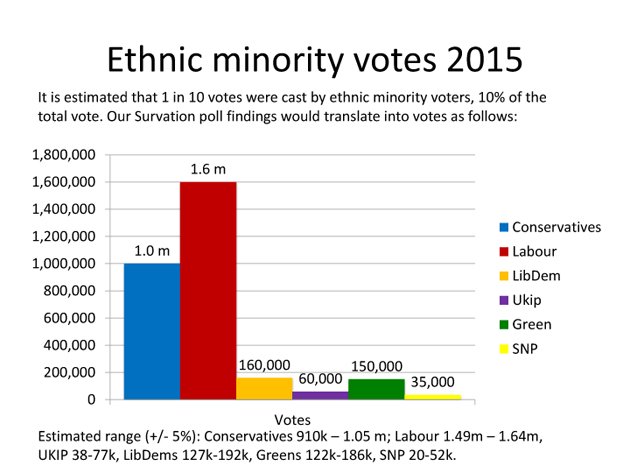
What is clear from these figures is that the Tories took BME votes from Labour in the South of the country suggesting that their pre election BME engagement strategy that saw David Cameron address faith communities like Jesus House, Festival of Light with over 40,000 African and Caribbean people in attendance and focusing on Hindu and Sikh business communities, paid off handsomely. Labour increased it votes among BME communities in the North.
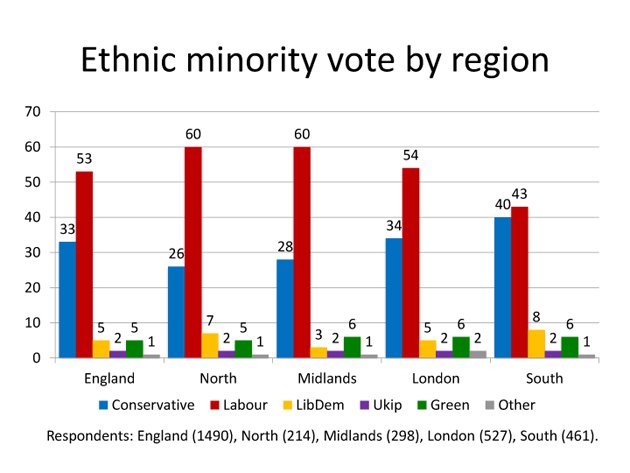
In the English regions the statistics are fascinating and show Labour, particularly in the South, losing significant numbers of BME votes, to the Tories:
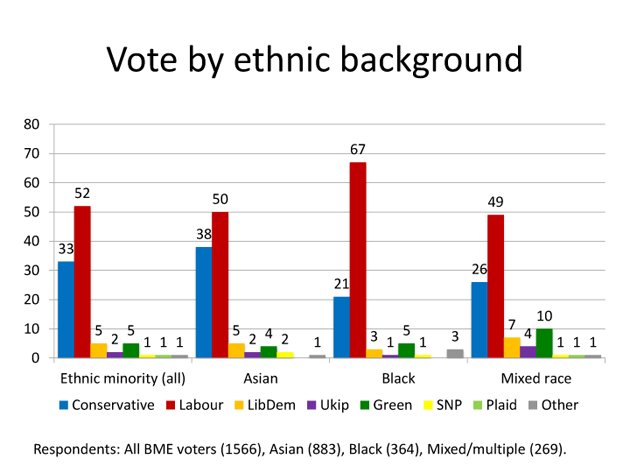
In general, the majority of the Asian community came out for the Tories and similarly the African, Caribbean and dual ethnicity voters supported Labour but with a significant and growing minority defecting to the Tories:
Asian: 50% Labour, 38% Conservative
Black: 67% Labour, 21% Conservative
Mixed race: 49% Labour, 26% Conservative
And this is how the distinct religious groups within the British BME communities voted:
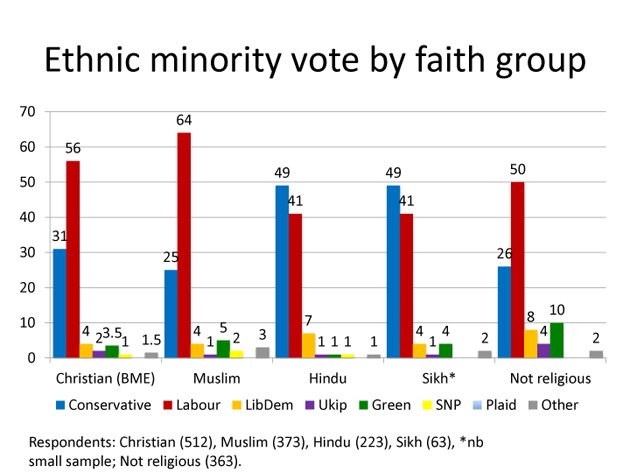
The clear conclusion is that there are substantial BME votes to be won if mainstream parties can reflect BME voters' concerns and motivate the 44% who did not vote this time around. This equates to almost 3 million BME votes. This confirms the OBV argument that British BME voters have emerged as a significant and substantive constituency on the British electoral landscape and their concerns must be addressed if politicians want to win their support.
Over the next year in terms of the London Mayoral elections and over the next five years up to the 2020 general election, the importance of the BME vote will only increase and that means mainstream parties will have to work harder to secure their support.
Lee Jasper
